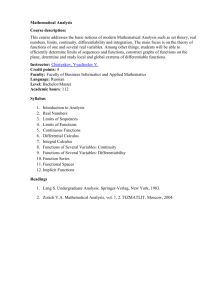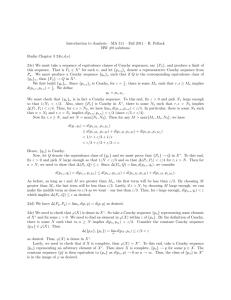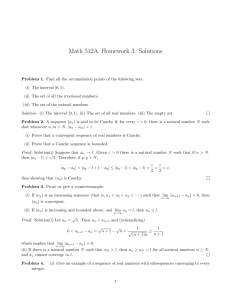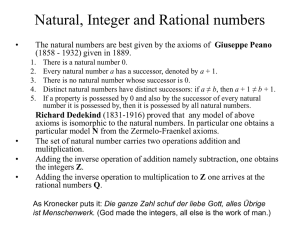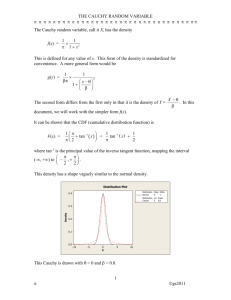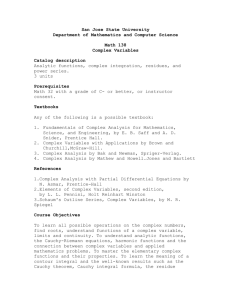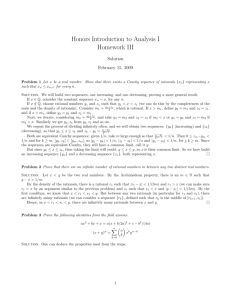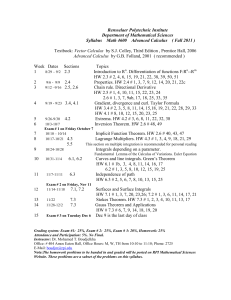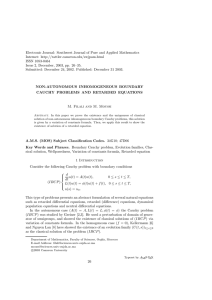Math 101: Course Summary
advertisement
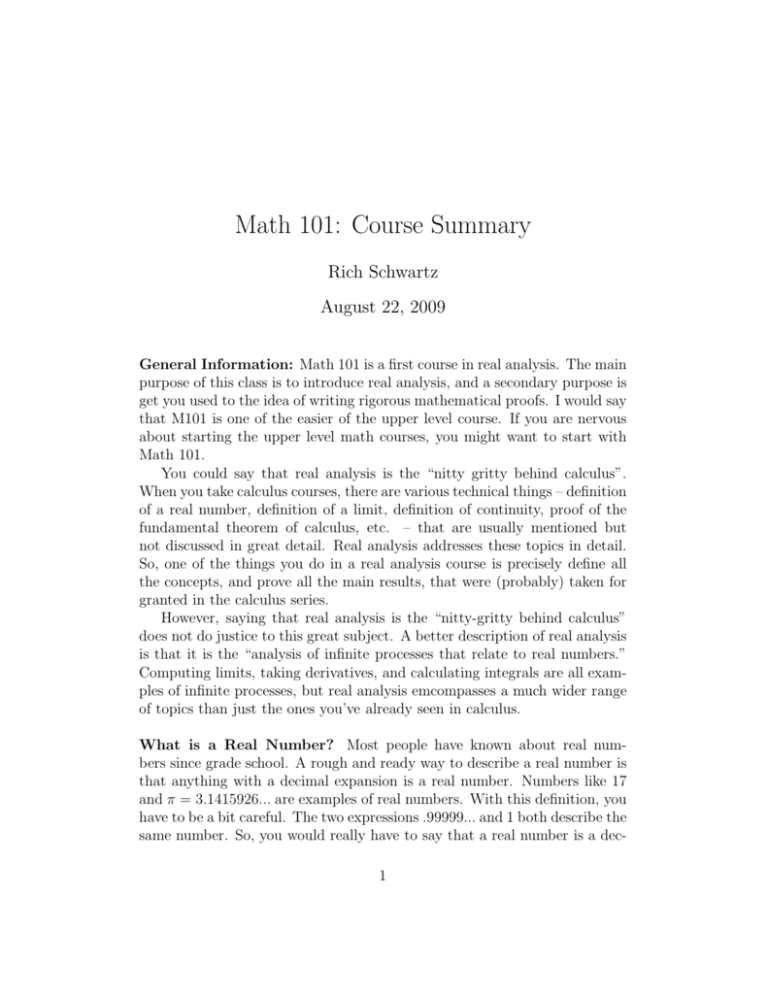
Math 101: Course Summary
Rich Schwartz
August 22, 2009
General Information: Math 101 is a first course in real analysis. The main
purpose of this class is to introduce real analysis, and a secondary purpose is
get you used to the idea of writing rigorous mathematical proofs. I would say
that M101 is one of the easier of the upper level course. If you are nervous
about starting the upper level math courses, you might want to start with
Math 101.
You could say that real analysis is the “nitty gritty behind calculus”.
When you take calculus courses, there are various technical things – definition
of a real number, definition of a limit, definition of continuity, proof of the
fundamental theorem of calculus, etc. – that are usually mentioned but
not discussed in great detail. Real analysis addresses these topics in detail.
So, one of the things you do in a real analysis course is precisely define all
the concepts, and prove all the main results, that were (probably) taken for
granted in the calculus series.
However, saying that real analysis is the “nitty-gritty behind calculus”
does not do justice to this great subject. A better description of real analysis
is that it is the “analysis of infinite processes that relate to real numbers.”
Computing limits, taking derivatives, and calculating integrals are all examples of infinite processes, but real analysis emcompasses a much wider range
of topics than just the ones you’ve already seen in calculus.
What is a Real Number? Most people have known about real numbers since grade school. A rough and ready way to describe a real number is
that anything with a decimal expansion is a real number. Numbers like 17
and π = 3.1415926... are examples of real numbers. With this definition, you
have to be a bit careful. The two expressions .99999... and 1 both describe the
same number. So, you would really have to say that a real number is a dec1
imal expansion, but with the proviso that certain decimal expansions name
the same number. To be formal about it, you could say that the decimal
expansion 3.14159... is the limit of the series
3+
1
4
1
5
9
+
+
+
+
+ ....
10 100 1000 10000 100000
So, first of all, you would have to know about about series and limits. Then,
you would have to say that a real number is really an equivalence class of
such expansions. Making the decimal expansion definition work is actually
a bit clumsy, and so a real analysis class usually takes different (but closely
related) approaches.
A Definition of the Reals: I’ll give a definition of a real number that
assumes the existence and basic properties of the rational numbers. Defining
a real number is not usually the first thing that is done in M 101, but I hope
my explanation gives you a feel for what you’ll see in M101. Here we go.
A sequence of rational numbers {rn } is called Cauchy if for every integer
N > 0, there is another integer M > 0 such that
min(m, n) > M
⇒
|rn − rm | < 1/N.
Informally this definition says that the sequence {rn } becomes “eventually
nearly constant”: If you look far enough out (beyond the Mth term) then
all the terms are nearly the same (within 1/N of each other.) To relate this
to what I’ve already said, the sequence
r1 = 3;
r2 = 3 +
1
;
10
r3 = 3 +
1
4
+
;...
10 100
is a Cauchy sequence. You can turn any decimal expansion into a Cauchy
sequence in the way suggested by the example.
Two Cauchy sequences {rn } and {sn } are said to be equivalent if the
shuffled sequence r1 , s1 , r2 , s2 , r3 , s3 , .. is also a Cauchy sequence. For instance, the Cauchy sequences determined by the decimal expansions 1.0000
and 0.9999 are equivalent. By definition, a real number is an equivalence
class of Cauchy sequences. That is, a real number is an exhaustive collection
of Cauchy sequences, all of which are equivalent to each other.
Once we’ve defined real numbers in this way, we want to recover their
basic properties. For instance, how does one define x + y, where x and y are
2
real numbers as we’ve defined them? It works like this, Let {rn } be a Cauchy
sequence belonging to the equivalence class x and let {sn } be a Cauchy sequence in the equivalence class y. Then x + y is defined to be the equivalence
class of the sequence {rn +sn }. To make sure this works, there are a few little
things to check. For instance, you have to check that {rn + sn } is a Cauchy
sequence. Then you have to check that you would get the same answer if you
started with {rn′ } and {s′n }, different Cauchy sequences representing x and
y respectively. Once you make these checks, addition is defined. Then you
define subtraction, multiplication, etc, and check it all works. When you’re
done, you have a precise definition of the reals that is solidly built upon the
rationals, and you recover all the basic properties of the real number system
that you’d known informally for years.
So What? You might wonder what has been gained by this exercise. True,
we haven’t uncovered any mystical new properties of real numbers. However,
we can now say exactly what we mean by “real number”. Also, when it comes
time to deal with intricate properties of the reals, such as the existence of a
continuous but nowhere differentiable function, having a precise definition of
the reals (and continuity and differentiation) will give you tools to analyze
what is going on.
You might also worry that it will be impossible to do much work with
our definition of the reals, since it (perhaps) seems both complicated and
strange. This isn’t the case. Once you establish the basic properties of real
numbers (e.g. the associative law) you can use these properties freely without
going back to the original definition every time. Real analysis builds from
the ground up, but you don’t have to go back to the ground floor every time
you want to do something in the subject.
Limits: Once the real numbers are defined, you can talk about limits, continuity, etc. There are several approaches to all these definitions, and the
approach I’ll take is not necessarily the one you’ll see in M101. However, all
the approaches are pretty similar to each other.
A sequence {xn } of real numbers is said to converge to the number x if
for every integer N, there is some M such that
n>M
⇒
|xn − x| < 1/N.
The fact that |xn − x| makes sense for real numbers is one of the basic
properties alluded to above. Here some common ways this limit relationship
3
is denoted.
lim xn = x
n→∞
{xn } → x;
xn → x.
Once limits are defined, their basic properties are established. For instance,
if xn → x and yn → y then xn yn → xy.
Continuity: Let R be the set of real numbers. A function f : R → R
is said to be continuous at a point x if the following holds for all sequences
{xn } that converge to x.
xn → x
⇒
f (xn ) → f (x).
In other words, f maps sequence converging to x over to sequences converging
to f (x). The function f is said to be continuous if it is continuous at all real
numbers. Once you have the definition of continuity, you establish basic
properties. For instance, if f and g are continuous, then so are
f + g;
f − g;
f g;
f ◦ g.
The last one is the composition of f and g.
Differentiability: Here is a related definition, dealing with the case where
f is not necessarily defined on all of R. Assuming that f is defined on all
points y such that 0 < |x − y| < ǫ, we say that
lim f (y) = A
y→x
if the following holds. If xn → x then f (xn ) → A. This is supposed to hold
for all sequence {xn } that converge to x such that |xn − x| < ǫ.
With this related definition, we can talk about differentiability. A function f : R → R is said to be differentiable at x if there is some C such
that
f (y) − f (x)
lim
= C.
y→x
y−x
This definition makes sense because the function
g(y) =
f (y) − f (x)
y−x
is defined for all points except x. f is said to be differentiable if f is differentiable at every point.
4
Open Sets After going through and recovering all the basic results from
a calculus course, M 101 goes in a different direction and introduces a subject called point set topology. The idea is to define open sets of real numbers
and to carefully study how they interact with continuity and related notions.
I’ll give a small sample of this subject.
An open interval in R is a set of the form
{y| |y − x| < ǫ}.
A subset U ⊂ R is open if every point x ∈ U is contained in an open interval
Ix such that Ix ⊂ U as well. A set S is closed if the complement R − S is
open.
Open sets are closely related to continuous functions. Suppose f : R → R
is a function. For each set U we have the inverse image f −1 (U), consisting
of points x such that f (x) ∈ U. Let’s temporarily call f nice if it has the
following property. If U is open then so if f −1 (U). One of the basic results
in point set topology is that f is continuous if and only if f is nice.
Accumulation Points: Let S be an infinite subset of R. A point x ∈ R is
said to be an accumulation point of S if it has the following property: Every
open set containing x intersects S in infinitely many points. So, no matter
how much we shrink our open set around x, we can’t avoid points of S. One
of the theorems you learn in M101 is the Bolzano-Weierstrass Theorem: Every bounded infinite set in Rn has an accumulation point. If you put an
infinite number of points in a bounded region on the line, they have to pile
up somewhere. Here bounded means that K is contained in some interval
[−N, N].
Compactness: A subset K of R is said to be compact if K has the following property. If {Un } is any (possibly infinite collection) of open sets
whose union contains K, then there is a finite subcollection U1 , ..., Un whose
union contains K. This definition is a bit hard to work with, and the HeineBorel Theorem from M 101 comes in handy. The Heine-Borel Theorem says
that K is compact if and only if K is closed and bounded.
Exotic Examples: Here are a few exotic examples of things you’ll understand after taking M101. These are things you most likely wouldn’t learn
in a calculus class.
5
• There exists a continuous function that is not differentiable at any
point.
• There exists a continuous curve f : R → R2 such that f (R) = R2 .
Such a curve is called a plane filling curve for obvious reasons.
• There exists a continuous function f : [0, 1] → [0, 1] whose derivative
exists and is 0 at every point except a set of length 0. Yet f (0) = 0 and
f (1) = 1. Somehow, f manages to increase from 0 to 1 even though its
derivative is (almost) always 0.
Beyond the Line: One of the advantages of the material in M101, especially
the point-set topology, is that it easily generalizes to higher dimensions. For
instance, in Rn , an open ball is defined just as we defined an open interval in
R, but with ky − xk replacing |y − x|. Once open balls are defined, one can
talk rigorously about open sets, continuity, closed sets, accumulation points,
the Heine-Borel theorem, the Bolzano-Weierstrass theorem, etc. M101 serves
as a good warm-up for real analysis in higher dimensions, the subject of M113
and M114.
6

